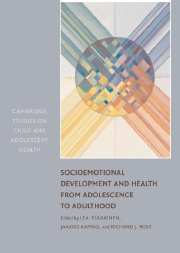Book contents
- Frontmatter
- Contents
- List of Contributors
- Preface
- Introduction
- PART I LONGITUDINAL AND BEHAVIORAL GENETIC APPROACHES
- PART II ADOLESCENT HEALTH-RELATED BEHAVIOR AND ADULT HEALTH
- PART III SOCIOEMOTIONAL BEHAVIOR IN EARLY ADOLESCENCE
- PART IV LIFE COURSE AND HEALTH
- 13 Identity Formation, Personal Control Over Development, and Well-Being
- 14 Sense of Coherence and Optimism: A More Positive Approach to Health
- 15 Unemployment and Psychological Distress, and Education as a Resource Factor for Employment
- 16 Personality, Work Career, and Health
- Summary and Future Directions
- References
- Author Index
- Subject Index
14 - Sense of Coherence and Optimism: A More Positive Approach to Health
Published online by Cambridge University Press: 07 December 2009
- Frontmatter
- Contents
- List of Contributors
- Preface
- Introduction
- PART I LONGITUDINAL AND BEHAVIORAL GENETIC APPROACHES
- PART II ADOLESCENT HEALTH-RELATED BEHAVIOR AND ADULT HEALTH
- PART III SOCIOEMOTIONAL BEHAVIOR IN EARLY ADOLESCENCE
- PART IV LIFE COURSE AND HEALTH
- 13 Identity Formation, Personal Control Over Development, and Well-Being
- 14 Sense of Coherence and Optimism: A More Positive Approach to Health
- 15 Unemployment and Psychological Distress, and Education as a Resource Factor for Employment
- 16 Personality, Work Career, and Health
- Summary and Future Directions
- References
- Author Index
- Subject Index
Summary
INTRODUCTION
The positive psychology movement has taken issue with psychology's exclusive focus on pathology and repairing damage. The three pillars of the research in positive psychology are (a) positive individual traits, (b) positive subjective experiences, and (c) positive institutions and communities (Seligman, 2003). Thus, positive psychology is the study of strengths and virtues rather than weaknesses and suffering. Its focus is on learning how to develop the qualities that allow individuals to flourish.
The three pillars of positive psychology are introduced in this chapter in the context of the Jyväskylä Longitudinal Study of Personality and Social Development (JYLS) data. The positive personality characteristics introduced are a sense of coherence and optimism. Positive subjective experiences in relation to a sense of coherence and optimism include life satisfaction and health, among others. Positive institutions refer to the favorable family and school backgrounds that are thought to be a basis for the successful development of a sense of coherence and optimism.
We begin this chapter by exploring the theoretical definitions of sense of coherence and optimism and introducing results concerning the construct validity of these two personality concepts. Next, we display a theoretical introduction to the development of a sense of coherence and optimism and demonstrate their antecedents from adolescence to adulthood. Finally, we explore the idea of sense of coherence and optimism as health promoters by displaying their hypothesized channels to health and examining their associations to various health indicators.
- Type
- Chapter
- Information
- Publisher: Cambridge University PressPrint publication year: 2006
- 12
- Cited by

